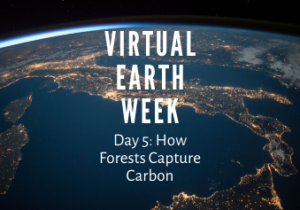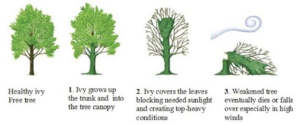Virtual Earth Week, Part 5: How Forests Capture Carbon

For the 50th anniversary of Earth Day, we have put together a 5-part blog series, releasing a new post each day of Earth Week. DNDA has also launched a new video series about environmentally friendly cooking on our YouTube channel, and we will be drawing a winner for our Earth Day giveaway today at 5 pm. Stay safe, stay healthy, and join us in celebrating Earth Week from home!
In urban forests such as those stewarded by DNDA-Nature Consortium, invasive plants have been outcompeting native vegetation, including mature trees such as Douglas firs and western red cedars. Many invasive plant species in Washington state were introduced during colonization, with settlers bringing non-native plants into the landscape. Once the old-growth forests of the region were deforested to make room for cities, invasive species took advantage of the empty space, to the detriment of many native plant species. For example, English ivy has the ability to climb large trees and shade over their leaves, resulting in tree death.
Forests overrun by invasive species have lower plant biodiversity and fewer trees. Our organization aims to combat urban tree deaths and curb invasive plant spread by removing invasive species, planting native vegetation and maintaining forest ecosystem health. In 2019, we installed 4,326 plants across ten urban forested parks and an urban wetland.
There are countless reasons to love trees as much as we do at DNDA: they make oxygen, provide habitat and food for wildlife, filter out air and water pollution, and beautify natural areas like parks and protected lands. But did you know that they can also remove carbon dioxide from the atmosphere and store it in their leaves, bark, trunk and stems? Roughly 50 percent of a tree’s biomass tissue is composed of carbon. By trapping and sequestering carbon in their living tissues, trees and other plants are one of the largest sinks of carbon in the global carbon cycle.

Emission sources and sinks for carbon in the global carbon cycle. Values above a carbon dioxide flux of 0 gigatons of carbon per year represent the amount of carbon released, while values below 0 GtC/year represent the amount of carbon stored.
The global carbon cycle tracks where carbon is produced and stored around the planet. Several large sources of carbon are the natural decomposition of organic materials, changes in land use, and burning fossil fuels. Land-use change refers to the conversion of natural areas such as forests to agricultural lands or developed human landscapes. This results in a release of stored carbon, since forests store more carbon than croplands or buildings.
The largest sinks of carbon are the oceans, the atmosphere, and the terrestrial biosphere. Soils and trees play a large role in terrestrial carbon sequestration: it’s estimated that soils sequester up to three times as much carbon as vegetation does. An acre of trees can capture up to one ton of carbon dioxide each year, depending on the age of the forest.
Younger forests can sequester carbon faster than older, mature forests, but mature forests still have more carbon stored in them. In a developing forest, plants grow quickly and compete with each other for access to resources. Carbon gets released back into the soil and atmosphere when plants die, but the amount of growth a young forest undergoes often outweighs the losses in carbon from decaying plants. As the forest matures, growth rates slow down until trees have reached their maximum heights. Eventually, the forest reaches a steady state, where both death rates and growth rates are low. In such states, carbon emissions from tree deaths are balanced with carbon storage from tree growth.
Planting trees is one of the iconic Earth Day activities, and hopefully now you understand its significance. We hope you can find different ways to benefit your local trees this week. Whether that’s removing ivy rings around your backyard trees or simply educating yourself on tree carbon sequestration, your actions can improve the ecological health of your community.
We would like to thank you for taking part in our first virtual Earth Day. We hope you learned more about the challenges of climate change and the actions you can take to make a difference. Collective systematic change is the key to healing our planet and restoring balance between humans and the natural environment. We hope to see you at our next volunteer restoration event, and we look forward to celebrating another Earth Day with you next year. Don’t forget to make an environmental pledge online to be entered in our Earth Day giveaway- we’re drawing a winner tonight at 5:00 PM PST!

